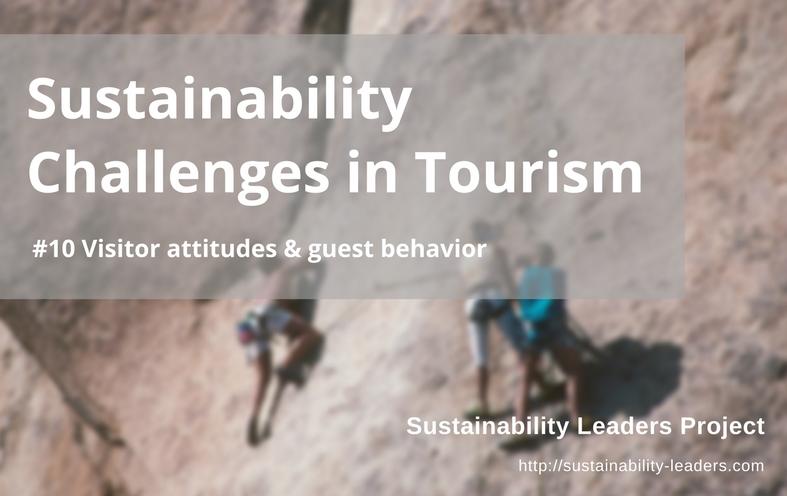Visitor attitudes and guest behavior are the focus of this tenth and last post of our special series on the key challenges preventing tourism businesses and destinations from becoming more sustainable.
In our interviews with tourism sustainability professionals we often include a question about which they consider the main challenges regarding tourism sustainability. Among the many (and very diverse) answers so far, we’ve identified 10 themes and areas of concern. Visitor attitude and guest behavior are among those.
Below three extracts and answers from our interviews, intended to offer you a snapshot of expert views on the topic. We strongly recommend you to read the full versions of the interviews. Sustainability challenges in tourism are very location-specific, and as such best understood in context.
Visitor attitudes, guest behavior and expectations
Carlos Sandoval, Argentina:
“Undoubtedly, the greatest challenge that we have had, and continue to have, is to meet and exceed the expectations of Yacutinga Lodge’s guests during their stay with us. Even if we did the impossible to achieve it, there are external factors that are outside our control and work against customer satisfaction.”
Ross Lardner, Australia:
“I would say one of the main challenges we have faced [at Sydney Harbour YHA] is bringing all the guests along with us on the sustainability journey. The most effective sustainability features are those that operate without any co-operation from the guests, such as rainwater tanks and solar panels. However, features that require guest involvement can cause a challenge to not only explain the way they work to guests, but to actually get guests to use it correctly.”
“One example is the air-conditioning in our rooms, which is designed to only operate if the windows are closed. A key-card is inserted in the power saving device and the air-conditioning is activated at reception. These three steps were designed to not have empty rooms heated or cooled, and to reduce the chance of rooms being over-heated or cooled. However, as it is not the normal situation you encounter in a hotel or hostel, many guests are confused despite the information we provide.”
Estrela Matilde, São Tomé and Príncipe:
Looking back, which sustainability aspects do you find the most challenging when developing a remote island destination, such as Principe?
“From my personal perspective, the most challenging aspect is the balance between sustainable alternatives, indigenous and traditional, and excellent service, product quality and safety assurance. In a remote destination such as São Tomé and Príncipe, it is vital to ensure to learn how to think outside the box in a much simpler perspective than what we Europeans are used to. Otherwise it becomes very complicated.”
“It is also essential to be able to change the tourist’s perspective. Teach our visitors that sustainable tourism includes experiencing local life and local realities, and not to have Western expectations which do not apply here and are completely out of context.”
“There are still many customers who want a unique and paradise-like experience, with Western luxury, and are unwilling to experience the site. These are the tourists whom we want to change and teach that the only experience is in getting to know the communities, try local dishes, eating fish on the beach freshly caught and fried in the fisherman’s own home…”
“And then there’s the tourist who comes to Africa with the prospect of “poor thing” and who thinks that it will make a difference to hand out candy to children on the street because it makes them very happy. It is fundamental teaching that this behavior is wrong and has very serious social consequences: it stimulates begging among children, takes them to associate the tourist with getting something back, triggers fights among children for sweets and causes health problems. And, of course, the one who we find on the street is not necessary the one who need it the most. We encourage that the tourists bring donations, but that they be responsible, that is, bring the essentials (no candy), and deliver those to persons who can make a fair and equitable distribution.
Thoughts:
Clearly, the best sustainability strategy or technical solution doesn’t work if visitors and guests don’t (know how to) participate. Communication is essential and the best way to go about it is to tell stories and use a bit of humor. The last thing we want on our vacation is to be lectured by the ‘eco-police’. Throughout the last years we have featured many great examples of sustainability well communicated.
Some of those are Landgut Stober near Berlin in Germany, Siloso Beach Resort in Singapore, and of course a must read on the topic is our interview with Professor Xavier Font of Surrey University, the ‘guru’ of sustainability marketing and communication.
This concludes our special series on sustainability challenges in tourism. We hope you’ve enjoyed it and if you did, please share with your colleagues and friends.
Our most recent articles on sustainable tourism challenges:
- Achieving Sustainable Tourism: These Are the Key Challenges
- Sustainable Tourism Trends and Challenges in 2019: Expert Panel
- 11 Challenges for Sustainability Entrepreneurs in Tourism: Pitfalls to Avoid
The information and views set out in this article are those of the authors (interviewees) and do not necessarily reflect the official opinion of the organizations they work for.
Enjoyed this snapshot of expert views on why visitor attitude and guest behavior constitute a key sustainability challenge for tourism businesses and destinations? Share and spread the word!
rxbuywithoutprescriptiononline.net/zyban.html
Buy Zithromax online
buy female viagra online












